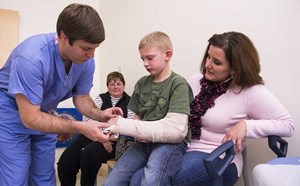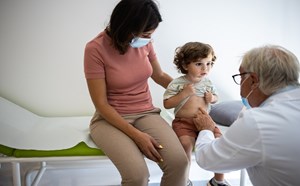
Update on COVID-19 and Pediatric Patients for Emergency Department Physicians
The COVID-19 pandemic is rapidly evolving and the healthcare challenges are continuing to increase and evolve. Despite the widespread global incidence and increasing number of cases, the epidemiology and clinical presentation of COVID-19 in pediatric patients is not well understood. The majority of children seen for emergency medical problems in the United States are seen in general emergency departments, not pediatric-specific institutions, and this will likely continue with the current pandemic. The information below is based on current evidence, and is meant to assist in the evaluation and management of pediatric patients with suspected or confirmed COVID-19. However, it must be noted that new information is available on a daily basis, and the understanding of COVID-19 including the epidemiology, clinical presentation, testing recommendations, and clinical management is subject to change. Additionally, the information below does not pertain nor apply to neonates.
Epidemiology:
- Large proportion of pediatric cases appear to be associated with household contact.1
- Incubation period average of 5-6 days, range of 2-14 days.1
- Pediatric patients appear to have the lowest rate of infection for all age groups, though the apparently low incidence may be due to a significant proportion of asymptomatic and mild cases in children that are not recognized and tested.2, 3
- Current reports suggest very low rates of hospitalization and critical disease (including ICU admission) in pediatric patients.2, 3 Of those patients considered to have critical disease, the majority were <1 year of age.4
- The mortality rate in pediatric patients appears to be very low. A recent release from the Centers for Disease Control and Prevention (MMWR) reported no pediatric deaths related to COVID-19 in the United States as of March 16th, 2020.1 Two epidemiological studies from China, the first with 965 pediatric patients (subset of larger study cohort) and the second with 2,143 pediatric patients (731 laboratory-confirmed cases, 1,412 suspected cases), reported only 1 death respectively in each cohort of patients.3, 4
- There is very limited data on pediatric patients with chronic disease states and comorbid conditions. Patients with chronic disease states and comorbid conditions, particularly those with pulmonary/respiratory diseases and those considered immunosuppressed, whether congenital or acquired (including patients on chronic steroids), must be considered high risk for developing severe or critical disease.
Transmission:
- Person-to-person spread via respiratory droplets is thought to be the predominant means of transmission.
- It is presumed that transmission can also occur via contaminated fomites. At least one study has demonstrated that SARS-CoV-2 (the virus that causes COVID-19) may remain viable in aerosols for up to 3 hours, on cardboard for up to 24 hours, and on plastic and stainless steel for as long as 3 days.5
- It is unclear whether infection can be spread via other body fluids (e.g. blood, stool). SARS-CoV-2 RNA has been detected in stool specimens, and in pediatric patients it has been demonstrated to persist longer in stool than the nasopharynx.6 More information is available on the CDC website.
Clinical Presentation:
- A significant proportion of pediatric patients appear to be asymptomatic. In two reports, the proportion of asymptomatic cases was 12.9% and 15.8% respectively in confirmed cases.4, 7
- The most common clinical characteristics in symptomatic pediatric patients appear to be fever and cough.7, 8, 9
Other clinical characteristics include pharyngeal erythema, diarrhea, fatigue, rhinorrhea, nasal congestion, vomiting, and fatigue.7, 8 - Tachypnea and hypoxia have been identified in more severe cases.7, 8
Testing Recommendations:
- Testing recommendations for pediatric patients are similar to those for adults.
- Testing recommendations are rapidly evolving as the pandemic continues and should be obtained from the CDC (https://www.cdc.gov/coronavirus/2019-nCoV/hcp/clinical-criteria.html) and the Florida Department of Health.
Management:
- No specific therapeutic drugs for COVID-19 are currently approved by the FDA.
Initial management priorities should include infection control measures, and supportive treatment as indicated. - Though several potential therapeutic agents are currently being investigated, none are currently recommended by the CDC for treating pediatric patients with COVID-19.
- Pediatric patients with asymptomatic or mild disease, who are not high-risk patients (e.g., immunosuppressed), and for which admission is not clinically indicated, may not require transfer to a pediatric center.
- The decision to admit a patient to the hospital or continue observation at home must be made on a case-by-case basis.
As a significant proportion of pediatric patients appear to have a mild disease course associated with COVID-19, it is likely that many will be candidates for outpatient management. - Pediatric patients managed on an outpatient basis must be provided clear information and instructions regarding potential progression of signs and symptoms, and return precautions.
References:
- Zimmerman P, Curtis, N. Coronavirus Infections in Children Including COVID-19: An Overview of the Epidemiology, Clinical Features, Diagnosis, Treatment and Prevention Options in Children. The
- Pediatric Infectious Disease Journal: March 12, 2020 – Volume Online First – Issue – doi: 10.1097/INF.0000000000002660.
- Centers for Disease Control and Prevention (CDC). (2020, March 18) Severe Outcomes Among Patients with Coronavirus Disease 2019 (COVID-19) – United States, February 12-March 16, 2020. MMWR. Morbidity and Mortality Weekly Report.
- The Novel Coronavirus Pneumonia Emergency Response Epidemiology Team. The Epidemiological Characteristics of an Outbreak of 2019 Novel Coronavirus Diseases (COVID-19) — China, 2020[J]. China CDC Weekly, 2020, 2(8): 113-122.
- Dong Y, Mo X, Hu Y, et al. Epidemiological characteristics of 2143 pediatric patients with 2019 coronavirus disease in China. 2020; doi: 10.1542/peds.2020-0702
van Doremalen N, Bushmaker T, Morris DH, et al. Aerosol and Surface Stability of SARS-CoV-2 as - Compared with SARS-CoV-1. N Engl J Med. 2020 Mar 17. doi: 10.1056/NEJMc2004973. [Epub ahead of print]
- Xu Y, Xufang L, Bing Z. Characteristics of pediatric SARS-CoV-2 infection and potential evidence for persistent fecal viral shedding. Nature Medicine. https://doi.org/10.1038/s41591-020-0817-4
- Lu X, Zhang L, Du, H, et al. SARS-CoV-2 Infection in Children. N Engl J Med. 2020 Mar 18. doi: 10.1056/NEJMc2005073. [Epub ahead of print].
- Chen Z, Fu J, Shu Q, et al. Diagnosis and treatment recommendations for pediatric respiratory infection caused by the 2019 novel coronavirus. World J Pediatr (2020). https://doi.org/10.1007/s12519-020-00345-5
- Liu W, Zhang Q, Chen J, et al. Detection of Covid-19 in Children in Early January 2020 in Wuhan, China. N Engl J Med. 2020 Mar 12. doi: 10.1056/NEJMc2003717. [Epub ahead of print]
Written by the Pediatric Emergency Medicine Committee of the ACEP Florida Chapter





